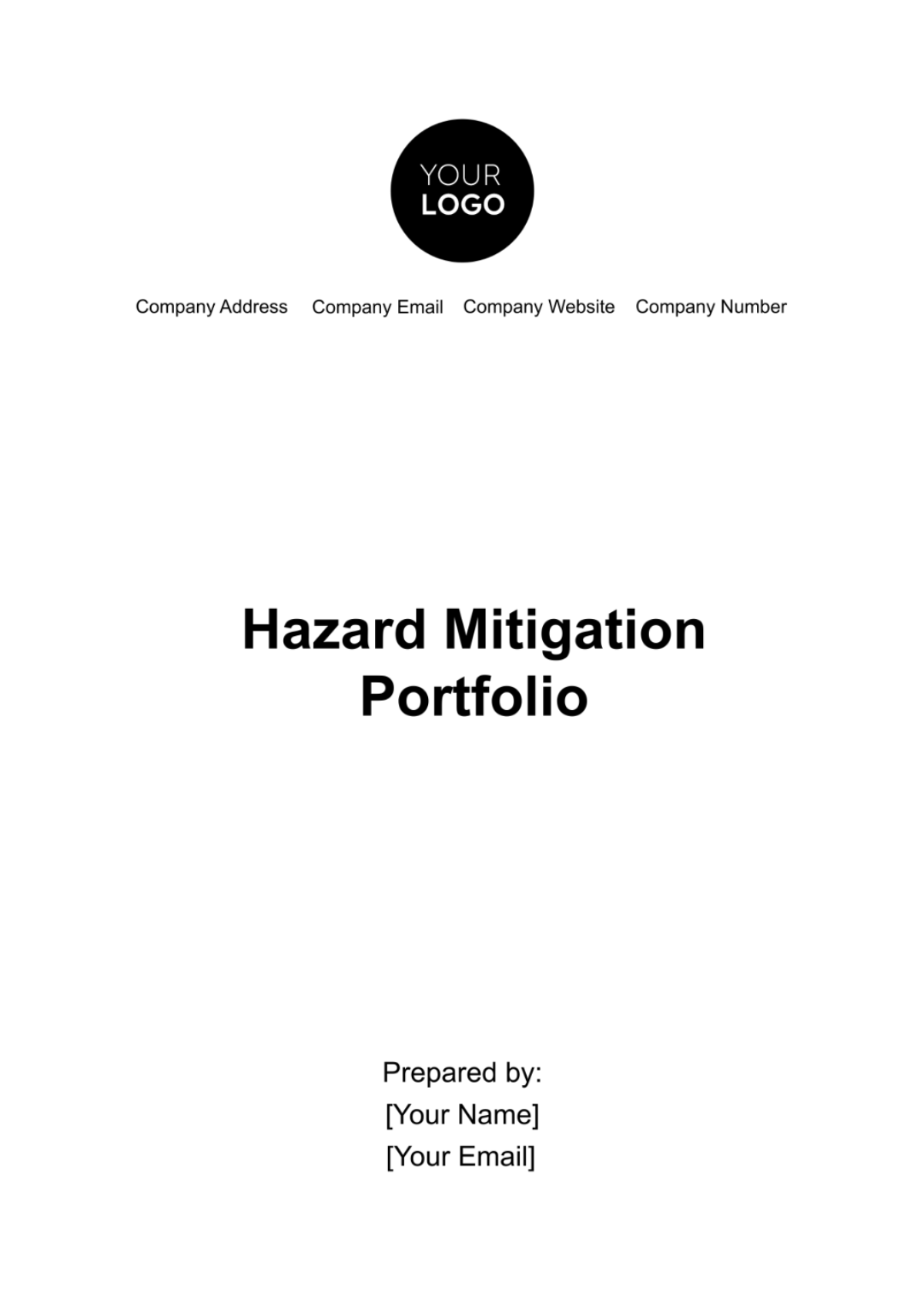Free Hazard Mitigation Portfolio

I. Executive Summary
Overview of Hazard Mitigation Goals The portfolio outlines [Your Company Name]'s commitment to mitigating workplace hazards. It establishes clear goals to identify, reduce, and manage various risks, aiming to enhance overall safety and minimize potential impacts on operations. |
Key Strategies Highlight The portfolio highlights strategies such as risk assessment, implementation of safety controls, employee training, and regular reviews. These strategies are crucial in creating a comprehensive approach to hazard mitigation, ensuring the well-being of employees and the continuity of business operations. |
II. Hazard Analysis
In-depth analysis of identified hazards and their potential impacts forms the foundation of effective mitigation.
A. Types of Hazards Identified
The portfolio categorizes hazards into physical, chemical, biological, and ergonomic, providing detailed descriptions of each. This categorization aids in understanding the nature of potential risks and guides appropriate mitigation strategies.
Hazard Type | Description | Mitigation Strategy Guidance |
Physical Hazards | Physical hazards include slips, trips, falls, machinery accidents, and electrical hazards. These are common in various workplace settings and can lead to significant injuries. | Implement safety training, enforce personal protective equipment use, and ensure regular equipment safety checks. |
Chemical Hazards | Chemical hazards involve exposure to harmful substances such as solvents, acids, and gases. Risks include chemical burns, poisoning, and respiratory problems. | Establish proper chemical handling protocols, ensure adequate ventilation, and provide appropriate protective equipment. |
Biological Hazards | Biological hazards are related to exposure to pathogens, viruses, and other microorganisms. They pose risks such as infections, allergic reactions, and other health complications. | Promote hygiene practices, use barrier protections, and implement health screening measures. |
Ergonomic Hazards | Ergonomic hazards arise from poor workplace design, repetitive movements, or improper body mechanics. They can lead to musculoskeletal disorders, eye strain, and chronic injuries. | Conduct ergonomic assessments, redesign workstations, and provide training on proper posture and equipment use. |
B. Hazard Impact Assessment
Each identified hazard is assessed for its potential impact on employee safety and business operations. The assessment considers factors like frequency, severity, and the possibility of mitigating the hazard, guiding prioritization in the mitigation strategy.
Hazard Type | Impact on Employee Safety | Impact on Business Operations | Mitigation Feasibility |
Physical Hazards | Potential for serious injuries or fatalities in case of accidents. | Operational disruptions, potential legal liabilities, and repair costs. | Highly feasible with safety training, PPE, and equipment maintenance. |
Chemical Hazards | Risk of acute or chronic health issues due to chemical exposure. | Workplace contamination, operational downtime, and health-related absences. | Moderately feasible with proper handling procedures and safety equipment. |
Biological Hazards | Possibility of infection, illness, or allergic reactions. | Employee absenteeism, productivity loss, and potential legal and health costs. | Feasibility varies; depending on the nature of the biological hazard and prevention measures. |
Ergonomic Hazards | Long-term musculoskeletal problems or acute injuries from poor ergonomics. | Decreased productivity, increased compensation claims, and higher employee turnover. | Feasible with ergonomic assessments and adjustments to workstations and practices. |
III. Mitigation Strategy Development
Strategic development of mitigation plans tailored to each identified hazard is crucial for effective management.
A. Strategy Formulation
For each type of hazard, specific mitigation strategies are developed. These include engineering controls, administrative measures, and personal protective equipment, tailored to address the unique aspects of each hazard.
Hazard Type | Engineering Controls | Administrative Measures | Personal Protective Equipment (PPE) |
Physical Hazards | Installation of safety guards on machinery, improved lighting, and slip-resistant flooring. | Safety protocols, regular safety training, and emergency drills. | Helmets, safety glasses, gloves, and protective footwear. |
Chemical Hazards | Chemical fume hoods, ventilation systems, and safe chemical storage solutions. | Chemical handling procedures, staff rotation to limit exposure, and incident reporting systems. | Chemical-resistant gloves, aprons, and face shields. |
Biological Hazards | Biohazard containment systems, air filtration units, and controlled access zones. | Infection control policies, hygiene education, and restricted area protocols. | Gloves, masks, gowns, and eye protection for high-risk areas. |
Ergonomic Hazards | Ergonomically designed equipment, adjustable workstations, and task automation. | Regular breaks, job rotation, and training on correct body mechanics. | Supportive seating, anti-fatigue mats, and wrist supports. |
B. Resource Allocation
The portfolio outlines the allocation of resources like budget, personnel, and equipment for implementing these strategies. Efficient resource allocation is vital for the successful implementation of mitigation plans.
Hazard Type | Budget Allocation | Personnel Allocation | Equipment Allocation |
Physical Hazards | Funding for safety equipment upgrades and maintenance. | Dedicated safety officers and maintenance staff for equipment checks. | Provision of updated safety machinery and protective barriers. |
Chemical Hazards | Budget for chemical safety equipment and ventilation systems. | Chemical safety specialists and regular staff training sessions. | Supply of chemical storage cabinets, fume hoods, and spill kits. |
Biological Hazards | Investment in biohazard containment and air filtration systems. | Infection control team and regular health and safety audits. | Availability of biohazard suits, sterilization equipment, and safety signage. |
Ergonomic Hazards | Allocating funds for ergonomic tools and workstation redesign. | Ergonomics specialists and staff training on ergonomic practices. | Ergonomic chairs, adjustable desks, and task-specific tools. |
IV. Implementation Plan
Detailed implementation plans ensure the effective execution of mitigation strategies.
A. Action Plan
The portfolio sets out a comprehensive action plan for each mitigation strategy, including steps like upgrading equipment, revising procedures, and conducting training.
Hazard Type | Key Actions | Implementation Steps |
Physical Hazards | Upgrade safety equipment, revise emergency protocols, and conduct safety drills. | Identify equipment needing upgrades, develop new protocols, and schedule regular drills. |
Chemical Hazards | Implement new chemical handling procedures, install updated ventilation systems, and provide chemical safety training. | Review current chemical procedures, install ventilation, and organize training sessions. |
Biological Hazards | Establish infection control measures, conduct health screenings, and update biohazard response protocols. | Set up infection control policies, plan health screenings, and revise biohazard protocols. |
Ergonomic Hazards | Redesign workstations, provide ergonomic training, and implement regular health assessments. | Assess current workstations, design ergonomic training programs, and plan health assessments. |
B. Timeline and Milestones
A clear timeline with specific milestones is established for each strategy. This schedule ensures timely implementation and provides benchmarks for tracking progress.
Hazard Type | Implementation Start Date | Timeline | Milestones |
Physical Hazards | [Month Day, Year] | 6 months for equipment upgrades, 3 months for protocol revision, and monthly drills. | Completion of equipment upgrades, finalization of new protocols, and establishment of regular drill schedule. |
Chemical Hazards | [Month Day, Year] | 4 months for ventilation system installation, 2 months for procedure implementation, ongoing training. | Successful installation of ventilation systems, implementation of new chemical procedures, and first training session conducted. |
Biological Hazards | [Month Day, Year] | 5 months for infection control setup, monthly health screenings, and 3 months for protocol updates. | Infection control measures were in place, the first health screening was conducted, updated response protocols. |
Ergonomic Hazards | [Month Day, Year] | 3 months for workstation redesign, ongoing ergonomic training, and biannual health assessments. | Workstations redesigned, first training session completed, initial health assessment conducted. |
V. Monitoring and Evaluation
Ongoing monitoring and regular evaluation are key to maintaining the effectiveness of mitigation strategies.
A. Monitoring Mechanisms
Processes for continuous monitoring of hazards and the effectiveness of mitigation measures are established. These include regular safety audits and hazard inspections.
Hazard Type | Monitoring Processes |
Physical Hazards | Monthly safety audits, equipment inspections, and incident reporting. |
Chemical Hazards | Regular chemical inventory checks, air quality testing, and health surveillance. |
Biological Hazards | Continuous biohazard monitoring, hygiene inspections, and employee health screenings. |
Ergonomic Hazards | Ergonomic assessments, workstation reviews, and employee feedback surveys. |
B. Evaluation Criteria
The portfolio defines criteria for evaluating the effectiveness of mitigation strategies, such as reduction in incident rates and employee feedback. This evaluation is essential for continuous improvement of hazard mitigation efforts.
Hazard Type | Evaluation Criteria |
Physical Hazards | Decrease in reported accidents, compliance with safety regulations, and employee feedback on safety protocols. |
Chemical Hazards | Reduction in chemical exposure incidents, adherence to chemical safety standards, and feedback from safety audits. |
Biological Hazards | Lower rates of biological contamination, compliance with health regulations, employee health and safety feedback. |
Ergonomic Hazards | Reduction in ergonomic-related complaints, adherence to ergonomic standards, and feedback from ergonomic assessments. |
Prepared by:
[Your Name],
[Your Job Title]
[Your Email] | [Your Number]
© [Year] [Your Company Name]. All Rights Reserved.
- 100% Customizable, free editor
- Access 1 Million+ Templates, photo’s & graphics
- Download or share as a template
- Click and replace photos, graphics, text, backgrounds
- Resize, crop, AI write & more
- Access advanced editor
Introducing the Hazard Mitigation Portfolio Template from Template.net. This editable and customizable tool equips you to tackle risks efficiently. Crafted for ease, it's editable in our Ai Editor Tool, ensuring seamless adaptation to your needs. Streamline your hazard mitigation strategies with this comprehensive solution.





























